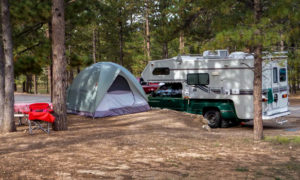

- Plan on a solar charging system that will replace what you use from your batteries PLUS 10%. That’s because anytime energy is transformed there is some loss.
- Your solar panel system should include metering and regulating devices.
- An average RV couple can meet most of their needs with three, full-size modules and two batteries. However, this rule of thumb can vary widely depending on your life style.
- Just because you have a 105AH “rated” battery, don’t think you can get 105AH out of it. Ideally, you shouldn’t use more than 20% (resting voltage of 12.5) of a battery’s rated capacity if you want it to last. That’s about 20+ amp hours a day. You can take 50% (resting volts of 12.3) out of a battery safely. But you must recharge it fully as soon as possible. Using more than 50% is a “deep cycle,” and a battery is only good for so many of them.
- You can increase solar panel output by tilting them toward the sun. If you mount them on the RV so they tilt, but can’t be rotated, then you’ll have to rotate the RV. Sometimes you can’t do that. The simpler way to get more power is to add an extra panel (or two) and leave them lying flat.
- Spend time figuring out where to put panels and building quality mounts for them. You’ll save in the long run with no leaks, no damage and maximum output.
- Don’t skimp on wire size, proper connectors or the equipment itself. You’ll ultimately be sorry if you do.
- You can install a solar system successfully with no more information than is in the basic instructions, or you can pay someone to do it for you. But, you won’t have the faintest idea what’s going on. On the other hand, you can read a few, simple books, make a hobby out of the whole thing and learn lots of neat tricks. How many hobbies pay for themselves?
- Some RV manufacturers are now “roughing in” solar panel wiring or even offering whole system installation. But, many are skimpily wired, thus defeating the whole idea. You must know what questions to ask.
You may want to read: RV Solar Electrical Panels provide Electricity to your RV and Use the Sun to Power Your RV
————-
“RV Electrical Systems: A Basic Guide to Troubleshooting, Repairing and Improvement” covers both AC and DC electrical systems and is another must have. Excellent 12 volt coverage and the best source on 120 volt AC systems. If it’s not covered in this book, you can probably get along without it. The authors go into extraordinary detail without getting into engineering “lingo” and they tell you things nobody else does, and those things many authors assume you already know — that you don’t. RV Electrical Systems is available at Amazon.
—————-






